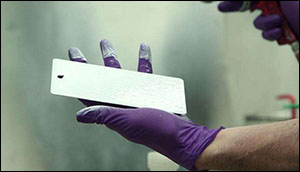Glass paint could keep metal roofs and other structures cool
17. 8. 2015 | Phys.org; American Chemical Society | www.phys.org
Sunlight can be brutal. It wears down even the strongest structures, including rooftops and naval ships, and it heats up metal slides and bleachers until they're too hot to use.
To fend off damage and heat from the sun's harsh rays, scientists have developed a new, environmentally friendly paint out of glass that bounces sunlight off metal surfaces - keeping them cool and durable. Glass, which is made out of silica, would be an ideal coating. It's hard, durable and has the right optical properties. But it's very brittle.

To address that aspect in a new coating, Jason J. Benkoski, who is at the Johns Hopkins University Applied Physics Lab, started with silica, one of the most abundant materials in the earth's crust. He modified one version of it, potassium silicate, that normally dissolves in water. His tweaks transformed the compound so that when it's sprayed onto a surface and dries, it becomes water resistant.
Unlike acrylic, polyurethane or epoxy paints, Benkoski's paint is almost completely inorganic, which should make it last far longer than its counterparts that contain organic compounds. His paint is also designed to expand and contract with metal surfaces to prevent cracking. Mixing pigments with the silicate gives the coating an additional property: the ability to reflect all sunlight and passively radiate heat. Since it doesn't absorb sunlight, any surface coated with the paint will remain at air temperature, or even slightly cooler. That's key to protecting structures from the sun.
Read more at Phys.org
Image Credit: American Chemical Society
-jk-




